Pablo Zegers
Video-based Human Action Recognition using Deep Learning: A Review
Aug 07, 2022



Abstract:Human action recognition is an important application domain in computer vision. Its primary aim is to accurately describe human actions and their interactions from a previously unseen data sequence acquired by sensors. The ability to recognize, understand, and predict complex human actions enables the construction of many important applications such as intelligent surveillance systems, human-computer interfaces, health care, security, and military applications. In recent years, deep learning has been given particular attention by the computer vision community. This paper presents an overview of the current state-of-the-art in action recognition using video analysis with deep learning techniques. We present the most important deep learning models for recognizing human actions, and analyze them to provide the current progress of deep learning algorithms applied to solve human action recognition problems in realistic videos highlighting their advantages and disadvantages. Based on the quantitative analysis using recognition accuracies reported in the literature, our study identifies state-of-the-art deep architectures in action recognition and then provides current trends and open problems for future works in this field.
A Unified Deep Framework for Joint 3D Pose Estimation and Action Recognition from a Single RGB Camera
Jul 16, 2019



Abstract:We present a deep learning-based multitask framework for joint 3D human pose estimation and action recognition from RGB video sequences. Our approach proceeds along two stages. In the first, we run a real-time 2D pose detector to determine the precise pixel location of important keypoints of the body. A two-stream neural network is then designed and trained to map detected 2D keypoints into 3D poses. In the second, we deploy the Efficient Neural Architecture Search (ENAS) algorithm to find an optimal network architecture that is used for modeling the spatio-temporal evolution of the estimated 3D poses via an image-based intermediate representation and performing action recognition. Experiments on Human3.6M, MSR Action3D and SBU Kinect Interaction datasets verify the effectiveness of the proposed method on the targeted tasks. Moreover, we show that our method requires a low computational budget for training and inference.
A Deep Learning Approach for Real-Time 3D Human Action Recognition from Skeletal Data
Jul 08, 2019



Abstract:We present a new deep learning approach for real-time 3D human action recognition from skeletal data and apply it to develop a vision-based intelligent surveillance system. Given a skeleton sequence, we propose to encode skeleton poses and their motions into a single RGB image. An Adaptive Histogram Equalization (AHE) algorithm is then applied on the color images to enhance their local patterns and generate more discriminative features. For learning and classification tasks, we design Deep Neural Networks based on the Densely Connected Convolutional Architecture (DenseNet) to extract features from enhanced-color images and classify them into classes. Experimental results on two challenging datasets show that the proposed method reaches state-of-the-art accuracy, whilst requiring low computational time for training and inference. This paper also introduces CEMEST, a new RGB-D dataset depicting passenger behaviors in public transport. It consists of 203 untrimmed real-world surveillance videos of realistic normal and anomalous events. We achieve promising results on real conditions of this dataset with the support of data augmentation and transfer learning techniques. This enables the construction of real-world applications based on deep learning for enhancing monitoring and security in public transport.
Learning to Recognize 3D Human Action from A New Skeleton-based Representation Using Deep Convolutional Neural Networks
Dec 26, 2018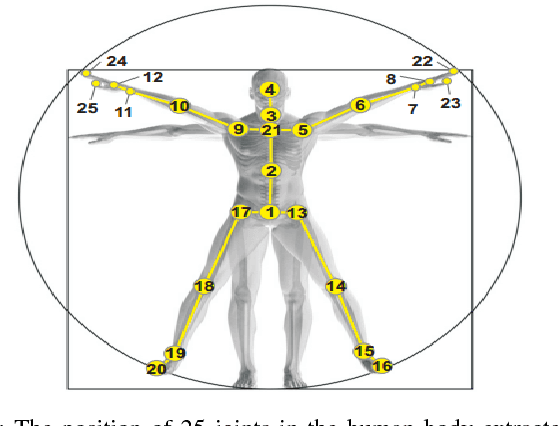
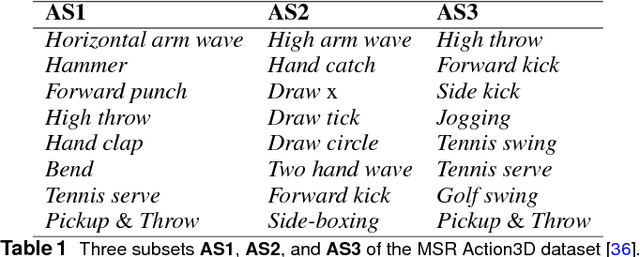

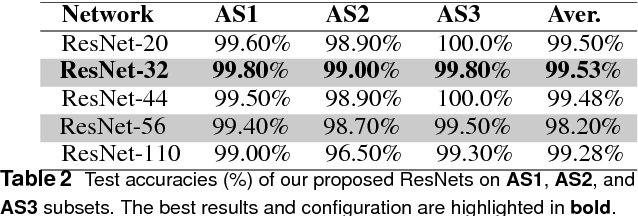
Abstract:Recognizing human actions in untrimmed videos is an important challenging task. An effective 3D motion representation and a powerful learning model are two key factors influencing recognition performance. In this paper we introduce a new skeleton-based representation for 3D action recognition in videos. The key idea of the proposed representation is to transform 3D joint coordinates of the human body carried in skeleton sequences into RGB images via a color encoding process. By normalizing the 3D joint coordinates and dividing each skeleton frame into five parts, where the joints are concatenated according to the order of their physical connections, the color-coded representation is able to represent spatio-temporal evolutions of complex 3D motions, independently of the length of each sequence. We then design and train different Deep Convolutional Neural Networks (D-CNNs) based on the Residual Network architecture (ResNet) on the obtained image-based representations to learn 3D motion features and classify them into classes. Our method is evaluated on two widely used action recognition benchmarks: MSR Action3D and NTU-RGB+D, a very large-scale dataset for 3D human action recognition. The experimental results demonstrate that the proposed method outperforms previous state-of-the-art approaches whilst requiring less computation for training and prediction.
Skeletal Movement to Color Map: A Novel Representation for 3D Action Recognition with Inception Residual Networks
Jul 18, 2018



Abstract:We propose a novel skeleton-based representation for 3D action recognition in videos using Deep Convolutional Neural Networks (D-CNNs). Two key issues have been addressed: First, how to construct a robust representation that easily captures the spatial-temporal evolutions of motions from skeleton sequences. Second, how to design D-CNNs capable of learning discriminative features from the new representation in a effective manner. To address these tasks, a skeletonbased representation, namely, SPMF (Skeleton Pose-Motion Feature) is proposed. The SPMFs are built from two of the most important properties of a human action: postures and their motions. Therefore, they are able to effectively represent complex actions. For learning and recognition tasks, we design and optimize new D-CNNs based on the idea of Inception Residual networks to predict actions from SPMFs. Our method is evaluated on two challenging datasets including MSR Action3D and NTU-RGB+D. Experimental results indicated that the proposed method surpasses state-of-the-art methods whilst requiring less computation.
Exploiting deep residual networks for human action recognition from skeletal data
Mar 21, 2018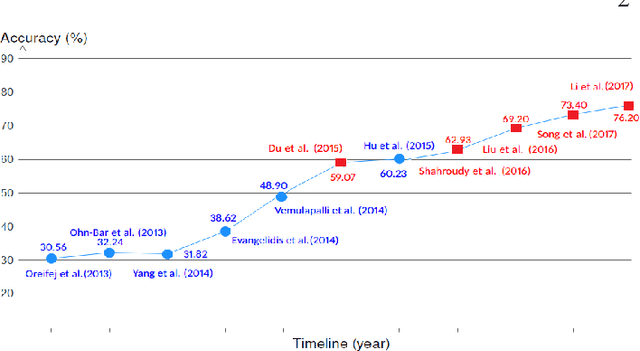
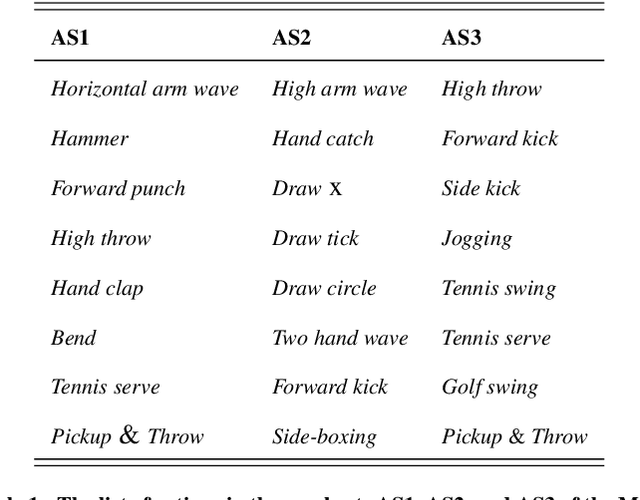
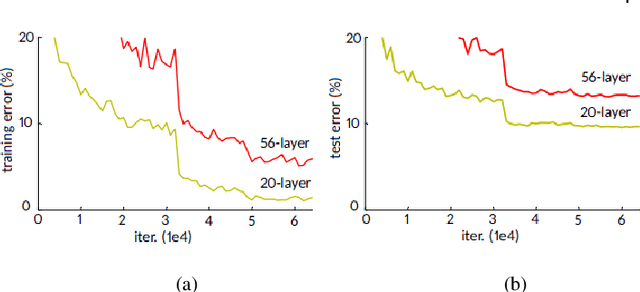
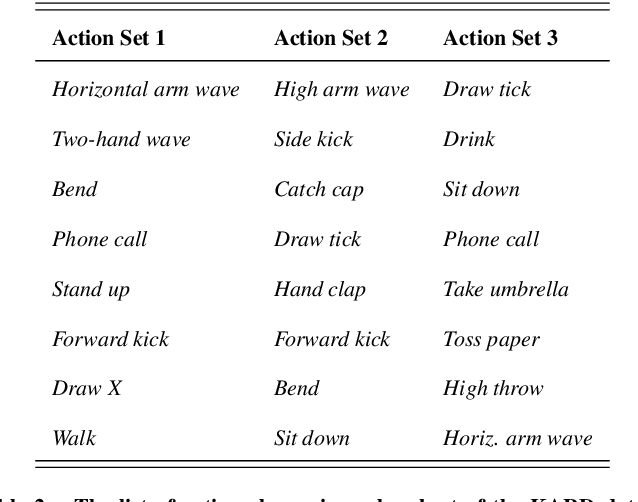
Abstract:The computer vision community is currently focusing on solving action recognition problems in real videos, which contain thousands of samples with many challenges. In this process, Deep Convolutional Neural Networks (D-CNNs) have played a significant role in advancing the state-of-the-art in various vision-based action recognition systems. Recently, the introduction of residual connections in conjunction with a more traditional CNN model in a single architecture called Residual Network (ResNet) has shown impressive performance and great potential for image recognition tasks. In this paper, we investigate and apply deep ResNets for human action recognition using skeletal data provided by depth sensors. Firstly, the 3D coordinates of the human body joints carried in skeleton sequences are transformed into image-based representations and stored as RGB images. These color images are able to capture the spatial-temporal evolutions of 3D motions from skeleton sequences and can be efficiently learned by D-CNNs. We then propose a novel deep learning architecture based on ResNets to learn features from obtained color-based representations and classify them into action classes. The proposed method is evaluated on three challenging benchmark datasets including MSR Action 3D, KARD, and NTU-RGB+D datasets. Experimental results demonstrate that our method achieves state-of-the-art performance for all these benchmarks whilst requiring less computation resource. In particular, the proposed method surpasses previous approaches by a significant margin of 3.4% on MSR Action 3D dataset, 0.67% on KARD dataset, and 2.5% on NTU-RGB+D dataset.
Learning and Recognizing Human Action from Skeleton Movement with Deep Residual Neural Networks
Mar 21, 2018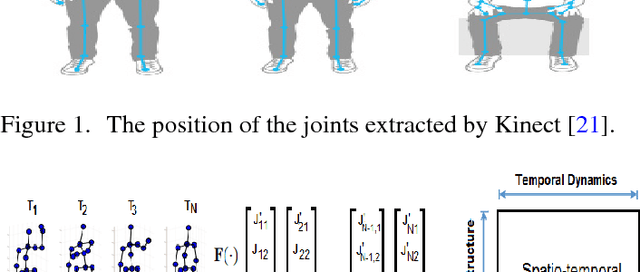
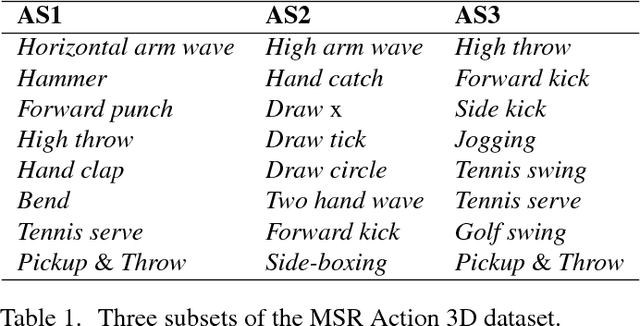

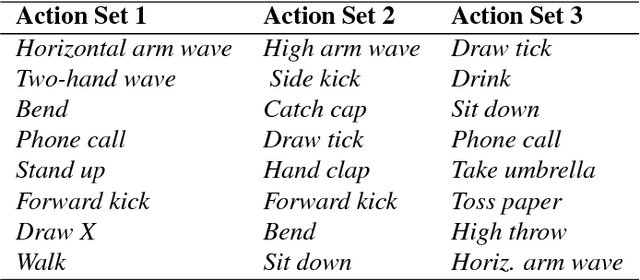
Abstract:Automatic human action recognition is indispensable for almost artificial intelligent systems such as video surveillance, human-computer interfaces, video retrieval, etc. Despite a lot of progress, recognizing actions in an unknown video is still a challenging task in computer vision. Recently, deep learning algorithms have proved its great potential in many vision-related recognition tasks. In this paper, we propose the use of Deep Residual Neural Networks (ResNets) to learn and recognize human action from skeleton data provided by Kinect sensor. Firstly, the body joint coordinates are transformed into 3D-arrays and saved in RGB images space. Five different deep learning models based on ResNet have been designed to extract image features and classify them into classes. Experiments are conducted on two public video datasets for human action recognition containing various challenges. The results show that our method achieves the state-of-the-art performance comparing with existing approaches.
Exploiting Spatio-Temporal Structure with Recurrent Winner-Take-All Networks
Mar 15, 2017



Abstract:We propose a convolutional recurrent neural network, with Winner-Take-All dropout for high dimensional unsupervised feature learning in multi-dimensional time series. We apply the proposedmethod for object recognition with temporal context in videos and obtain better results than comparable methods in the literature, including the Deep Predictive Coding Networks previously proposed by Chalasani and Principe.Our contributions can be summarized as a scalable reinterpretation of the Deep Predictive Coding Networks trained end-to-end with backpropagation through time, an extension of the previously proposed Winner-Take-All Autoencoders to sequences in time, and a new technique for initializing and regularizing convolutional-recurrent neural networks.
Computational Intelligence Challenges and Applications on Large-Scale Astronomical Time Series Databases
Sep 25, 2015



Abstract:Time-domain astronomy (TDA) is facing a paradigm shift caused by the exponential growth of the sample size, data complexity and data generation rates of new astronomical sky surveys. For example, the Large Synoptic Survey Telescope (LSST), which will begin operations in northern Chile in 2022, will generate a nearly 150 Petabyte imaging dataset of the southern hemisphere sky. The LSST will stream data at rates of 2 Terabytes per hour, effectively capturing an unprecedented movie of the sky. The LSST is expected not only to improve our understanding of time-varying astrophysical objects, but also to reveal a plethora of yet unknown faint and fast-varying phenomena. To cope with a change of paradigm to data-driven astronomy, the fields of astroinformatics and astrostatistics have been created recently. The new data-oriented paradigms for astronomy combine statistics, data mining, knowledge discovery, machine learning and computational intelligence, in order to provide the automated and robust methods needed for the rapid detection and classification of known astrophysical objects as well as the unsupervised characterization of novel phenomena. In this article we present an overview of machine learning and computational intelligence applications to TDA. Future big data challenges and new lines of research in TDA, focusing on the LSST, are identified and discussed from the viewpoint of computational intelligence/machine learning. Interdisciplinary collaboration will be required to cope with the challenges posed by the deluge of astronomical data coming from the LSST.
Period Estimation in Astronomical Time Series Using Slotted Correntropy
Dec 13, 2011



Abstract:In this letter, we propose a method for period estimation in light curves from periodic variable stars using correntropy. Light curves are astronomical time series of stellar brightness over time, and are characterized as being noisy and unevenly sampled. We propose to use slotted time lags in order to estimate correntropy directly from irregularly sampled time series. A new information theoretic metric is proposed for discriminating among the peaks of the correntropy spectral density. The slotted correntropy method outperformed slotted correlation, string length, VarTools (Lomb-Scargle periodogram and Analysis of Variance), and SigSpec applications on a set of light curves drawn from the MACHO survey.
 Add to Chrome
Add to Chrome Add to Firefox
Add to Firefox Add to Edge
Add to Edge